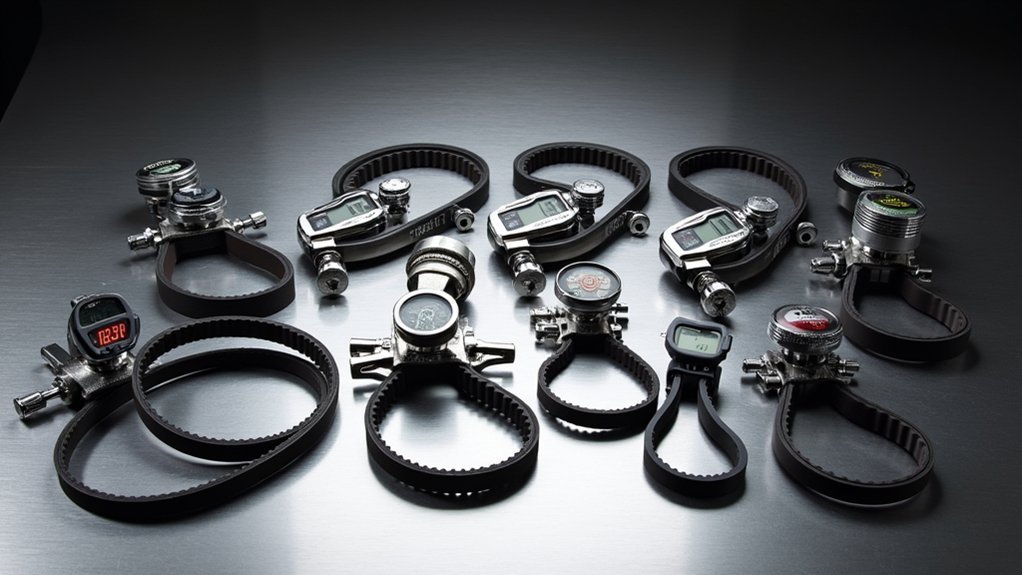You’ll face countless belt maintenance challenges throughout your automotive career, and having the right tensioning tools can make or break your efficiency. Whether you’re dealing with serpentine belts in cramped engine bays or measuring precise tension specifications, the difference between professional-grade equipment and basic tools becomes painfully obvious. The ten essential tools we’ve identified will transform how you approach belt work, but choosing the wrong one could cost you time, money, and credibility.
Belt Tension Gauge (BTG-2) 95506 Measuring Range: 100-1000N
The Belt Tension Gauge (BTG-2) 95506 delivers precision measurements between 100-1000N, making it the ideal choice for mechanics and technicians who demand accuracy within +/- 3kg tolerances. You’ll appreciate its needle measurement method that provides effective tension assessment for professional applications. This gauge correctly measures belt tension while helping you determine the belt’s coverage area. The 10-100kg range accommodates various belt types and sizes you’ll encounter in automotive and industrial settings. You can rely on its consistent performance to guarantee proper belt installation and maintenance. This tool eliminates guesswork, giving you confidence in your tensioning work.
Best For: Mechanics and technicians working in automotive and industrial settings who need precise belt tension measurements with reliable accuracy for proper installation and maintenance.
Pros:
- Delivers precise measurements with +/- 3kg accuracy tolerance for professional-grade reliability
- Wide measuring range of 100-1000N (10-100kg) accommodates various belt types and sizes
- Needle measurement method provides effective and consistent tension assessment
Cons:
- Limited to measuring range of 100-1000N, which may not cover extremely light or heavy-duty applications
- Requires manual operation with needle method, which may be slower than digital alternatives
- Accuracy tolerance of +/- 3kg may not meet requirements for ultra-precision applications
DURATECH 15-Piece Universal Ratcheting Serpentine Belt Tool Set
When you’re working on serpentine belt maintenance across multiple vehicle types, DURATECH’s 15-piece universal ratcheting tool set delivers the versatility you need for both professional shop work and DIY projects. The carbon steel construction with blackened surface treatment guarantees exceptional durability and corrosion resistance, while the 14-inch extension bar and ratcheting wrench help you access tight engine spaces efficiently.
You’ll appreciate the offset design that navigates around obstacles, plus the retaining ring that keeps tools securely attached during use. The molded plastic case keeps everything organized for transport and storage, making belt removal, installation, and adjustment straightforward across various vehicle applications.
Best For: Professional mechanics and DIY enthusiasts who need a versatile, durable tool set for serpentine belt maintenance across multiple vehicle types and tight engine spaces.
Pros:
- High-quality carbon steel construction with blackened surface treatment provides exceptional durability and corrosion resistance
- 14-inch extension bar and offset ratcheting design allow easy access to tight engine spaces and navigation around obstacles
- Comprehensive 15-piece set with molded storage case offers versatility for various vehicle applications and keeps tools organized
Cons:
- Case hinge durability has raised concerns among some users about long-term reliability
- Paint quality issues have been reported, potentially affecting the tool’s appearance over time
- Limited user review base with only 9 ratings may not provide comprehensive feedback on long-term performance
Belt Tension Gauge Tool, Adjustable 10 Pounds with L Shaped Pad
Motorcycle enthusiasts and automotive technicians who demand precision without breaking the bank will find exceptional value in the Gugxiom Belt Tension Gauge Tool. This lightweight 2.57-ounce instrument delivers fast, accurate measurements with clearly marked increments up to 10 pounds. You’ll appreciate its U-bracket design that holds belts firmly while reducing friction during adjustments. Simply position the tool at a 90° angle against the belt, record readings, and calculate deflection. Its universal compatibility works with any vehicle, ATV, or motorcycle with auxiliary transfer belts. With 4.4 out of 5 stars from 295 customers, you’re getting name-brand accuracy at an affordable price.
Best For: Motorcycle enthusiasts, automotive technicians, and DIY mechanics who need accurate belt tension measurements for vehicles, ATVs, or motorcycles without spending premium prices on name-brand tools.
Pros:
- Lightweight design at only 2.57 ounces with clearly marked increments for fast, accurate measurements up to 10 pounds
- Universal compatibility works with any vehicle, ATV, or motorcycle with auxiliary transfer belts
- Excellent value offering name-brand accuracy at an affordable price with strong customer satisfaction (4.4/5 stars from 295 reviews)
Cons:
- Some users report difficulty reading the zero and ten-pound markings clearly
- May require modifications for proper fit on certain applications
- Limited to 10-pound maximum tension measurement capacity
15PCS Universal Belt Tensioner Pulley Removal Tool Kit
Automotive technicians and dedicated DIY mechanics will find the 15PCS Universal Belt Tensioner Pulley Removal Tool Kit invaluable when working in cramped engine compartments where standard tools can’t reach. This extensive kit includes a curved wrench, five Torx adapters (E10-E18), and eight 12-point adapters (12-19mm) for serpentine and timing belt work. The high-quality steel construction withstands high temperatures while resisting rust and corrosion. At 12 inches long and weighing 2.68 pounds, it’s designed for tight spaces behind belts and near radiators. With 4.4-star customer ratings, a one-year warranty, and universal compatibility across car models, you’ll streamline belt maintenance efficiently.
Best For: Automotive technicians and DIY mechanics who need to work on serpentine and timing belts in tight engine compartments where standard tools cannot reach.
Pros:
- Universal compatibility with multiple car models through comprehensive adapter set (5 Torx and 8 12-point adapters)
- High-quality steel construction with high-temperature treatment provides durability and corrosion resistance
- Curved wrench design specifically engineered for accessing cramped spaces behind belts and near radiators
Cons:
- At 2.68 pounds, the tool kit may be heavier than some mechanics prefer for overhead work
- Requires some technical knowledge to select the correct adapter size for specific vehicle applications
- Limited to belt tensioner work and cannot be used for other general automotive repair tasks
GEARWRENCH 15 Piece Ratcheting Serpentine Belt Tool Set | 3680D
Professional mechanics and serious DIY enthusiasts will find the GEARWRENCH 15 Piece Ratcheting Serpentine Belt Tool Set (3680D) delivers unmatched versatility when working with spring-loaded belt tensioners. You’ll appreciate the innovative 5-degree ratcheting box end that’s unique among serpentine belt tools, allowing smooth operation in tight spaces. The extensive kit includes metric sockets (13-19mm), crowsfoot attachments, and adapters that handle various vehicle configurations. At just 1.4 pounds, you can maneuver easily around engine bays while the lifetime warranty protects your investment. With 4.8-star ratings from over 6,000 customers, you’re getting proven reliability for professional belt replacement work.
Best For: Professional mechanics and serious DIY enthusiasts who need a comprehensive tool set for serpentine belt replacement on vehicles with spring-loaded belt tensioners.
Pros:
- Unique 5-degree ratcheting mechanism allows smooth operation in tight engine spaces where traditional tools struggle
- Comprehensive 15-piece kit with metric sockets, adapters, and crowsfoot attachments covers a wide range of vehicle configurations
- Lightweight at 1.4 pounds with organized storage case and lifetime warranty backing for professional reliability
Cons:
- Limited to vehicles with spring-loaded belt tensioners, not suitable for all belt replacement scenarios
- Some customers report fitment limitations on certain vehicle models despite the extensive adapter selection
- Higher price point compared to basic belt tools, though justified by the ratcheting feature and comprehensive kit
ABN Belt Tension Gauge – Universal, 10 lbs Specification, Easy to Read
The ABN Belt Tension Gauge stands out as the ideal choice for mechanics and DIY enthusiasts who need precise belt adjustments across multiple vehicle types. This universal tool features a 10-pound specification with an L-shaped pad that accommodates all belt sizes. You’ll appreciate its compact 2.9 x 0.5 x 7.8-inch design and lightweight 2.82-ounce construction that won’t weigh down your toolbox. The included scale guarantees accurate measurements every time. With 4.6 out of 5 stars from over 1,700 customers, you’re getting proven reliability. It’s particularly effective after wheel service or belt replacements, making it essential for professional-quality results.
Best For: Mechanics and DIY enthusiasts who need to accurately measure and adjust belt tension across various vehicle types and belt drive systems.
Pros:
- Universal compatibility with all belt sizes thanks to the L-shaped pad design
- Lightweight and compact construction (2.82 ounces) that’s easy to store and transport
- High customer satisfaction with 4.6 out of 5 stars from over 1,700 verified ratings
Cons:
- Limited to 10-pound specification which may not cover all heavy-duty applications
- Metal construction could be prone to corrosion if not properly maintained
- No digital display, relying on analog scale readings which may be less precise than digital alternatives
21PCS GT2 Timing Belt Pulley Set for 3D Printer
For 3D printing enthusiasts and professionals seeking thorough belt maintenance solutions, this 21-piece GT2 timing belt pulley set delivers everything you’ll need in one convenient package. You’ll receive eight premium rubber timing belts in various lengths (110mm to 400mm), eight aluminum alloy pulleys with 20 teeth and 5mm bore, four carbon steel tensioner springs, and an Allen wrench. The belts feature round tooth profiles for smooth operation, while the pulleys undergo surface oxidation treatment for enhanced durability. The corrosion-resistant springs allow precise tension adjustments, improving your printing accuracy across 3D printers, milling machines, and drilling equipment.
Best For: 3D printing enthusiasts and professionals who need a comprehensive belt maintenance solution for multiple machines including 3D printers, milling machines, and drilling equipment.
Pros:
- Complete 21-piece set includes everything needed for belt maintenance with 8 different belt lengths, pulleys, tensioner springs, and tools
- High-quality materials including premium rubber belts with round tooth profiles, aluminum alloy pulleys with surface oxidation treatment, and corrosion-resistant carbon steel springs
- Versatile compatibility with multiple machine types beyond just 3D printers, including milling machines, gear shapers, and drilling machines
Cons:
- User reports indicate potential discrepancies in bore size specifications that may affect compatibility
- Warning about possible measurement errors suggests quality control inconsistencies
- Small parts pose safety concerns and require careful storage away from children
15PCS Professional Ratcheting Serpentine Belt Tool Set
Mechanics and DIY enthusiasts who regularly work on vehicles with spring-loaded tensioner pulleys will find the 15PCS Professional Ratcheting Serpentine Belt Tool Set an invaluable addition to their toolkit. You’ll appreciate the 14-inch extension bar that reaches tight engine compartments where standard tools can’t access. The kit includes seven metric sockets, three crowfoot wrenches, three square adapters, and a ratcheting wrench—everything you need for belt adjustments. Chrome vanadium steel construction guarantees durability, while the dipped plastic handle provides secure grip. The included storage case keeps components organized with clearly marked sizes for quick identification during repairs.
Best For: Mechanics and DIY enthusiasts who regularly work on vehicles with spring-loaded tensioner pulleys and need professional-grade tools to access tight engine compartments during serpentine belt maintenance.
Pros:
- 14-inch extension bar provides excellent reach for accessing hard-to-reach tensioner pulleys in narrow engine compartments
- Comprehensive 15-piece kit includes multiple socket sizes, crowfoot wrenches, and adapters for wide vehicle compatibility
- Durable chrome vanadium steel construction with comfortable dipped plastic handle ensures long-lasting performance and secure grip
Cons:
- At 4.16 pounds, the tool set is relatively heavy which may cause fatigue during extended use
- Limited to metric sizes only (13mm-19mm), potentially excluding vehicles that require standard/imperial measurements
- 30-day return policy may be insufficient for professional mechanics who need longer warranty coverage for heavy-duty use
1302546 Belt Tension Checker, Steel
Precision-driven mechanics and DIY enthusiasts who work with various V-belt systems will find the 1302546 Belt Tension Checker an invaluable addition to their toolkit. This steel tool eliminates guesswork by accurately measuring tension across all V-belt drives including 3L, 4L, 5L, A, B, C, AX, BX, CX, 3V, 5V, and 8V configurations. You’ll appreciate its compact, spring-loaded design that adjusts for 10 to 170 belt spans and handles up to 35 pounds of tension. While the tool functions effectively for wood chippers and air compressors, you should note that the sticker markings may wear with frequent use, potentially affecting long-term durability.
Best For: Precision-driven mechanics and DIY enthusiasts who work with various V-belt systems and need to eliminate guesswork when measuring belt tension across different drive configurations.
Pros:
- Compatible with all major V-belt drive types (3L, 4L, 5L, A, B, C, AX, BX, CX, 3V, 5V, 8V) with adjustable range for 10 to 170 belt spans
- Compact, spring-loaded steel design that’s easy to operate with step-by-step instructions included
- Effectively measures up to 35 pounds of tension, helping prevent premature belt wear in applications like wood chippers and air compressors
Cons:
- Non-painted sticker markings may peel off with regular use, affecting long-term durability
- Some users consider the product overpriced for its overall build quality
- May not withstand frequent professional use due to potential wear on the measurement markings
OEMTOOLS 24687 Serpentine Belt Tool Set
Automotive professionals and ambitious DIYers who regularly tackle serpentine belt maintenance will find the OEMTOOLS 24687 Serpentine Belt Tool Set an invaluable workshop companion. This all-encompassing kit includes a 3/8-inch drive handle, 1/2-inch drive adapter, and four shallow sockets (13mm, 15mm, 16mm, 18mm) for versatile tensioner compatibility. You’ll appreciate the durable alloy steel construction with black oxide finish that resists rust and guarantees long-term reliability. The tool’s thin, sturdy design lets you access tensioners in cramped engine compartments while providing necessary leverage for efficient belt removal and installation. With 4.4 stars from 243 customer ratings, this proven performer simplifies your serpentine belt work.
Best For: Automotive professionals and DIY mechanics who regularly perform serpentine belt maintenance and need a reliable tool set that provides access to tensioners in tight engine compartments.
Pros:
- Durable alloy steel construction with black oxide finish resists rust and ensures long-term reliability
- Thin, sturdy design allows access to tensioners in cramped spaces while providing necessary leverage
- Complete kit includes multiple socket sizes (13mm, 15mm, 16mm, 18mm) and adapters for versatile compatibility
Cons:
- Limited to four socket sizes which may not cover all vehicle applications
- At 2.3 pounds, it’s relatively heavy for a specialized tool set
- No storage case mentioned for organizing and protecting the components
Factors to Consider When Choosing Belt Tensioning Tools and Replacement Belts
When you’re selecting belt tensioning tools and replacement belts, you’ll need to evaluate several critical factors that directly impact your work’s success. Your tool’s measuring range must match your vehicle applications, while the material durability determines how long it’ll serve you in demanding conditions. You should also consider the tool’s accuracy, its ability to access cramped engine compartments, and whether it works across multiple vehicle makes and models.
Measuring Range Compatibility
Although belt tensioning tools may appear similar, their measuring ranges vary dramatically and directly impact your ability to achieve proper tension settings. You’ll find tools like the Belt Tension Gauge (BTG-2) offering 100-1000N measuring ranges for heavy-duty applications, while lighter tools max out at just 10 lbs. This difference matters greatly when working on different vehicle types.
Before purchasing, you must verify that your tool’s range aligns with your belt specifications and vehicle requirements. Check the manufacturer’s tension recommendations first, then select a tool that covers those specifications comfortably. Don’t forget about accuracy ratings either – some gauges provide +/- 3 kg accuracy, which can considerably affect your tension settings if you’re not accounting for this variance in your measurements.
Tool Material Durability
Durability determines whether your belt tensioning tool will withstand years of demanding automotive work or fail when you need it most. High-quality carbon steel and chrome vanadium steel offer superior strength and wear resistance compared to cheaper alternatives. You’ll want tools with black oxide finishes or similar protective coatings that resist corrosion from moisture and automotive fluids.
Robust construction prevents tool failure during high-tension applications, protecting both your engine components and preventing costly damage. Look for ergonomic grips paired with durable materials—they’ll improve your comfort while reducing slippage risks that can damage tools or cause injury.
Consider tools backed by warranties or lifetime guarantees, as manufacturers typically only offer these when they’re confident in their material quality and longevity.
Accuracy and Precision
Beyond material quality, accurate tension measurement forms the foundation of effective belt maintenance and prevents costly mechanical failures. You’ll need belt tension gauges with measuring ranges like 100-1000N to guarantee precise assessments across different applications. Look for tools featuring clear scales and marked measurements that allow you to take quick, accurate readings during the tensioning process.
Pay attention to accuracy specifications when selecting your tools. Quality gauges typically offer tolerance levels of +/- 3 kg, which guarantees reliable performance across various machinery types. When you maintain consistent and precise tension measurements, you’ll achieve ideal belt performance while reducing risks of slippage, excessive noise, and potential damage to engines or other critical components in your systems.
Accessibility in Tight Spaces
When working in cramped engine compartments or confined machinery spaces, you’ll need tensioning tools specifically designed for accessibility challenges. Extended reach designs with longer handles or extension bars let you maneuver around obstacles without struggling to position yourself awkwardly. Compact tool sets featuring ratcheting mechanisms minimize arm movement while maximizing efficiency in tight quarters.
Look for tools with adjustable components or interchangeable adapters that accommodate various belt sizes without requiring multiple bulky tools. Ergonomic grips become essential when you’re working in challenging positions, reducing hand fatigue and improving control during extended maintenance sessions. Choose tools constructed from durable materials like alloy steel, as cramped environments often subject equipment to increased wear and tear from constant contact with surrounding components.
Universal Vehicle Applications
Choosing the right belt tensioning tools requires evaluating their compatibility across multiple vehicle platforms and engine configurations. You’ll want tools that work effectively with both serpentine and timing belts across different makes and models, eliminating the need for brand-specific equipment. Look for thorough kits that include multiple adapters and extensions to accommodate various belt sizes and tensioning mechanisms you’ll encounter in diverse automotive applications.
Universal compatibility saves you money and storage space while ensuring you’re prepared for any vehicle that enters your workspace. The best tools feature interchangeable components that adapt to different manufacturer specifications, from compact cars to heavy-duty trucks. This versatility makes your investment more valuable and keeps you equipped to handle professional-quality belt maintenance across your entire customer base efficiently.
Storage and Portability
Storage and portability considerations directly impact your tool selection process when investing in belt tensioning equipment. You’ll want tools that come with molded plastic cases for organized storage and easy transport, especially if you’re a mobile mechanic or DIY enthusiast working in various locations.
Choose compact designs that minimize storage space requirements while allowing neat packing and quick access during maintenance tasks. Clear labeling on both tools and storage cases enhances efficiency by enabling rapid identification during repairs.
A robust carrying case protects your investment from damage while maintaining organization—crucial in professional environments with multiple tools. Consider lighter tool sets that enhance portability without sacrificing functionality, making them easier to handle in tight automotive spaces where maneuverability matters most.
Belt Type Specifications
Since different belt types demand specific tensioning approaches, you’ll need to match your tools to the exact specifications of your vehicle’s belts. V-belts, serpentine belts, and timing belts each require distinct tensioning methods for ideal performance. You must consider belt dimensions including width, length, and material type when selecting compatible tools.
Belt materials greatly impact your tensioning requirements. Rubber, polyurethane, and reinforced materials have varying elasticity and strength characteristics that affect tension measurements and adjustments. Serpentine belts typically require tension settings between 100-1000N depending on your vehicle’s specifications.
Check your vehicle’s maintenance manual for specific tension values. Proper tensioning prevents premature wear and guarantees belt longevity, making accurate specification matching vital for professional results.
Frequently Asked Questions
How Often Should I Check and Adjust Belt Tension on My Vehicle?
You should check your vehicle’s belt tension every 3,000 miles or during regular oil changes. If you notice squealing, cracking, or fraying, adjust immediately. Proper tension prevents premature wear and costly repairs.
What Are the Signs That Indicate a Belt Needs Immediate Replacement?
You’ll notice cracking, fraying, or glazing on the belt surface. Listen for squealing noises during startup or acceleration. Check for missing chunks, excessive stretching, or oil contamination that compromises the belt’s integrity.
Can I Use the Same Tensioning Tool for Different Belt Types?
You can’t use the same tensioning tool for different belt types. Each belt requires specific tools designed for its unique specifications, width, and tensioning requirements to guarantee proper installation and ideal performance.
What Safety Precautions Should I Take When Working With Belt Tensioning Tools?
You’ll want to wear safety glasses and gloves, guarantee the engine’s off and cool, release tension slowly to avoid snapback, keep fingers away from moving parts, and maintain proper footing.
How Do I Properly Store Belt Tensioning Tools to Maintain Their Accuracy?
Store your belt tensioning tools in a clean, dry environment away from extreme temperatures. Keep them in protective cases to prevent damage. Don’t stack heavy items on top, and regularly calibrate them to guarantee continued accuracy.





Leave a Reply